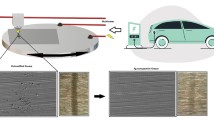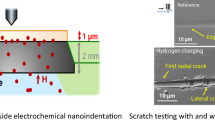Dependences of the electric conductivity of a contact and wear intensity of metal materials on the electric current density in sliding friction are obtained. It is established that alloying of the material basis leads to faster damage of the friction surface. The presence of about 40 аt.% oxygen in the surface layer is detected by the Auger spectrometry method. It is demonstrated by the x-ray diffraction method that FeO formed in the surface layer leads to an increase in the electric conductivity of the contact.
Similar content being viewed by others
References
I. M. Fedorchenko and L. I. Pugina, Composite Sintered Anti-Friction Materials [in Russian], Naukova Dumka, Kiev (1980).
B. I. Kostetskii, N. G. Nosovskii, and A. K. Karaulov, Surface Strength of Metals in Friction [in Russian], Tekhnika, Kiev (1976).
G. P. Shpen’kov, Physicochemistry of Friction (with Application to Selective Transfer), Publishing House of V. I. Lenin Belorussian State University, Minsk (1978).
V. V. Konchits, V. V. Meshkov, and N. K. Myshkin, Tribotechnology of Electric Contacts [in Russian], Nauka i Tekhnika, Minsk (1986).
M. I. Aleutdinova, Vopr. Materialoved., No. 2(70), 102–108 (2012).
V. G. Kuranov and A. N. Vinogradov, Trenie Smazka Mash., Mekhan., No. 8, 32–37 (2007).
V. V. Fadin and M. I. Aleutdinova, Russ. Phys. J., 52, No. 6, 607–611 (2009).
V. I. Vladimirov, in: Problems of Friction Physics and Wear Process: Physics of Wear Resistance of the Metal Surfaces, Collection of Works [in Russian], Publishing House of Leningrad Physical-Technical Institute of the USSR Academy of Sciences, Leningrad (1988), pp. 8–41.
V. V. Fadin and M. I. Aleutdinova, Russ. Phys. J., 55, No. 9, 1028–1033 (2013).
M. I. Glezer and V. A. Pozdnyakov, Deform. Razr. Mater., No. 4, 9–15 (2005).
Author information
Authors and Affiliations
Corresponding author
Additional information
Translated from Izvestiya Vysshikh Uchebnykh Zavedenii, Fizika, No. 4, pp. 16–21, April, 2013.
Rights and permissions
About this article
Cite this article
Fadin, V.V. Changes in the structure of the surface layer of metal materials upon friction and electric current loading. Russ Phys J 56, 378–383 (2013). https://doi.org/10.1007/s11182-013-0045-1
Received:
Published:
Issue Date:
DOI: https://doi.org/10.1007/s11182-013-0045-1




